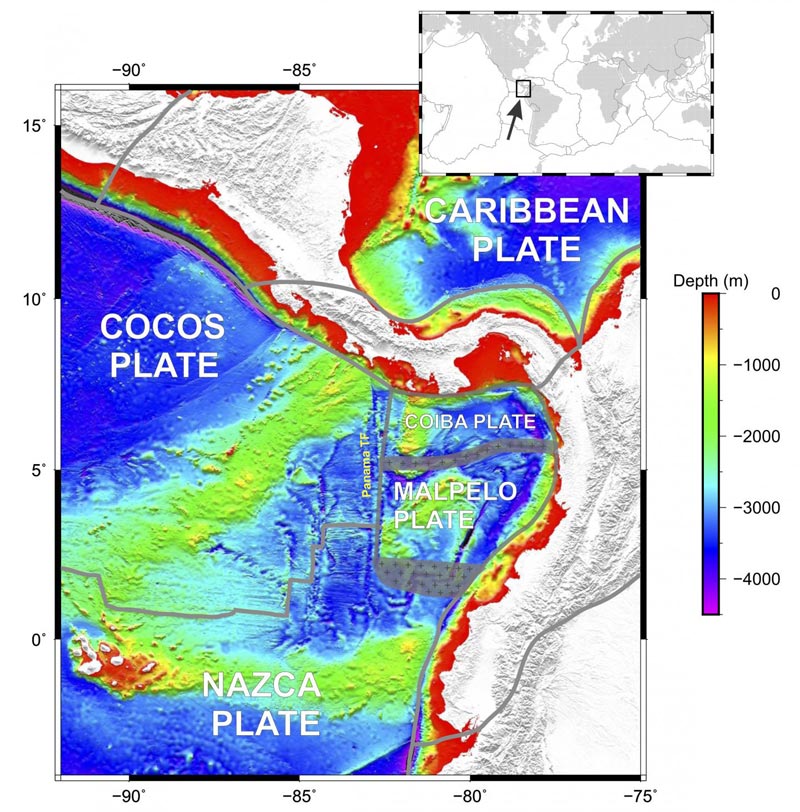

Misfit plates in the Pacific led Rice University scientists to the discovery of the Malpelo Plate between the Galapagos Islands and the South American coast.
Illustration by Tuo Zhang/Rice University
A microplate discovered off the west coast of Ecuador adds another piece to Earth's tectonic puzzle, according to Rice University scientists.
Researchers led by Rice geophysicist Richard Gordon discovered the microplate, which they have named “Malpelo,” while analyzing the junction of three other plates in the eastern Pacific Ocean.
The Malpelo Plate, named for an island and an underwater ridge it contains, is the 57th plate to be discovered and the first in nearly a decade, they said. They are sure there are more to be found.
The research by Gordon, lead author Tuo Zhang and co-authors Jay Mishra and Chengzu Wang, all of Rice, appears in Geophysical Research Letters.
How do geologists discover a plate? In this case, they carefully studied the movements of other plates and their evolving relationships to one another as the plates move at a rate of millimeters to centimeters per year.
The Pacific lithospheric plate that roughly defines the volcanic Ring of Fire is one of about 10 major rigid tectonic plates that float and move atop Earth's mantle, which behaves like a fluid over geologic time. Interactions at the edges of the moving plates account for most earthquakes experienced on the planet. There are many small plates that fill the gaps between the big ones, and the Pacific Plate meets two of those smaller plates, the Cocos and Nazca, west of the Galapagos Islands.
One way to judge how plates move is to study plate-motion circuits, which quantify how the rotation speed of each object in a group (its angular velocity) affects all the others. Rates of seafloor spreading determined from marine magnetic anomalies combined with the angles at which the plates slide by each other over time tells scientists how fast the plates are turning.
“When you add up the angular velocities of these three plates, they ought to sum to zero,” Gordon said. “In this case, the velocity doesn't sum to zero at all. It sums to 15 millimeters a year, which is huge.”
That made the Pacific-Cocos-Nazca circuit a misfit, which meant at least one other plate in the vicinity had to make up the difference. Misfits are a cause for concern – and a clue.
Knowing the numbers were amiss, the researchers drew upon a Columbia University database of extensive multibeam sonar soundings west of Ecuador and Colombia to identify a previously unknown plate boundary between the Galapagos Islands and the coast.
Previous researchers had assumed most of the region east of the known Panama transform fault was part of the Nazca plate, but the Rice researchers determined it moves independently. “If this is moving in a different direction, then this is not the Nazca plate,” Gordon said. “We realized this is a different plate and it's moving relative to the Nazca.”
Evidence for the Malpelo plate came with the researchers' identification of a diffuse plate boundary that runs from the Panama Transform Fault eastward to where the diffuse plate boundary intersects a deep oceanic trench just offshore of Ecuador and Colombia.
“A diffuse boundary is best described as a series of many small, hard-to-spot faults rather than a ridge or transform fault that sharply defines the boundary of two plates,” Gordon said. “Because earthquakes along diffuse boundaries tend to be small and less frequent than along transform faults, there was little information in the seismic record to indicate this one's presence.”
“With the Malpelo accounted for, the new circuit still doesn't close to zero and the shrinking Pacific Plate isn't enough to account for the difference either,” Zhang said. “The nonclosure around this triple junction goes down — not to zero, but only to 10 or 11 millimeters a year.
“Since we're trying to understand global deformation, we need to understand where the rest of that velocity is going,” he said. “So we think there's another plate we're missing.”
Plate 58, where are you?
Gordon is the W.M. Keck Professor of Geophysics. Zhang and Wang are Rice graduate students and Mishra is a Rice alumnus.
The National Science Foundation supported the research.
###
Jeff Falk
713-348-6775 jfalk@rice.edu
Mike Williams
713-348-6728
mikewilliams@rice.edu
Read the abstract at http://onlinelibrary.
This news release can be found online at http://news.
Follow Rice News and Media Relations via Twitter @RiceUNews
Related materials:
Rice University Global Tectonics (Gordon group): http://tectonics.
Richard Gordon bio: https:/
Wiess School of Natural Sciences: http://natsci.
GeoMapApp: http://www.
Images for download:
http://news.
Misfit plates in the Pacific led Rice University scientists to the discovery of the Malpelo Plate between the Galapagos Islands and the South American coast. (Credit: Illustration by Tuo Zhang/Rice University)
http://news.
Rice University researchers have discovered a microplate off the coast of South America. From left, Tuo Zhang, Richard Gordon and Chengzu Wang. (Credit: Jeff Fitlow/Rice University)
Located on a 300-acre forested campus in Houston, Rice University is consistently ranked among the nation's top 20 universities by U.S. News & World Report. Rice has highly respected schools of Architecture, Business, Continuing Studies, Engineering, Humanities, Music, Natural Sciences and Social Sciences and is home to the Baker Institute for Public Policy. With 3,879 undergraduates and 2,861 graduate students, Rice's undergraduate student-to-faculty ratio is 6-to-1. Its residential college system builds close-knit communities and lifelong friendships, just one reason why Rice is ranked No. 1 for quality of life and for lots of race/class interaction and No. 2 for happiest students by the Princeton Review. Rice is also rated as a best value among private universities by Kiplinger's Personal Finance. To read “What they're saying about Rice,” go to http://tinyurl.












